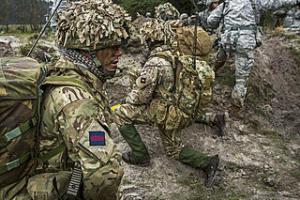ISISNATO should invade ISIS-held territory
In response to the terrorist attacks in Paris and Beirut, NATO should invade ISIS-held territory with the goal of creating two semiautonomous, predominantly Sunni Arab regions under restored Syrian and Iraqi sovereignty. This would be difficult and costly. But it is perhaps the only path to long-term solutions of both the Syrian refugee crisis and the threat of ISIS. No options are good, but this is the least bad alternative, and it will give all relevant regional and international actors something they want. Diplomacy is essential to a long-term solution to the Syrian civil war. But someone needs to take over ISIS’ territory, and local forces cannot do it alone. President Obama should reconsider his refusal to contribute ground forces. If he won’t, additional American advisers, special operations forces, air strikes, and intelligence could help troops from other NATO countries and local actors defeat ISIS and reach a lasting solution.

British and American troops during NATO exercise // Source: commons.wikimedia.org
In response to the terrorist attacks in Paris and Beirut, NATO should invade ISIS-held territory with the goal of creating two semiautonomous, predominantly Sunni Arab regions under restored Syrian and Iraqi sovereignty.
This would be difficult and costly. But it is perhaps the only path to long-term solutions of both the Syrian refugee crisis and the threat of ISIS.
No options are good, but, as someone who researches terrorism and insurgency, I believe this is the least bad alternative, and will give all relevant regional and international actors something they want.
Diplomacy won’t stop ISIS
Recent talks in Vienna, which some have hailed as significant progress, may help end the Syrian civil war. But diplomacy will not eliminate ISIS.
Representatives of nineteen outside powers, including the United States, Russia, Saudi Arabia, and Iran, agreed to table their disagreement over President Bashar Assad’s role in Syria’s future, and call for a ceasefire beginning in January.
Representatives of the Syrian government and some opposition groups — but not ISIS and al-Qaeda, or other terrorists identified by Jordan — would then set up a transitional government. The plan is to draft a new constitution and hold elections in 2017.
However, even if the future unfolds exactly as the optimistic diplomats hope — they are able to overcome the sticking point of Assad’s future, the ceasefire holds, all non-ISIS rebel groups are pacified, elections are held, and all parties honor the results — the threat of ISIS will remain.
ISIS wants an Islamic State on their terms, not the opportunity to run candidates in a pluralistic Syrian election.
Why eliminating ISIS’ “state” is necessary
Recent ISIS-linked attacks in Ankara, on a Russian passenger jet over the Sinai, in Beirut, and in Paris demonstrate that the danger is not contained within Iraq and Syria. Additionally, the related refugee crisis has strained countries throughout the Middle East and Europe. These interconnected problems are not solving themselves.
ISIS is different from other terrorist groups because of its “state.” It’s not a real state, but they do control territory. That territory provides them with oil and other revenue sources, a place to train and plan attacks, and a location to which recruits can travel.
Controlling territory also drives recruitment.
